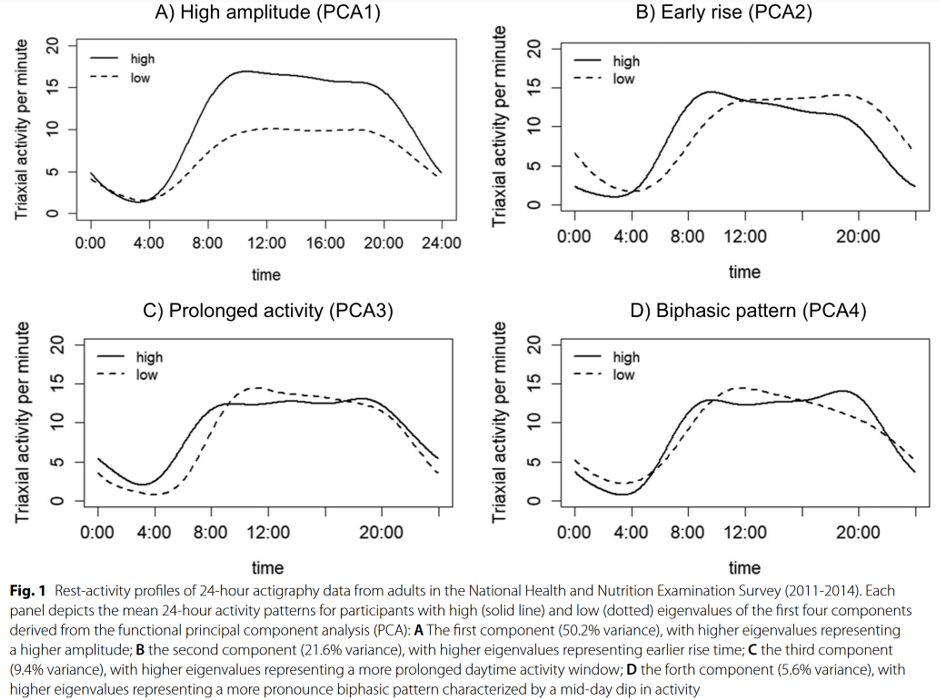Circadian Rhythms & Health
This research area delves into the links between circadian rhythms, rest-activity cycles, light exposure, and health outcomes such as diabetes, hypertension, and body mass index. By analyzing rest-activity patterns across demographics, the studies provide insights into how circadian alignment affects metabolic and cardiovascular health. These findings support the development of health strategies and interventions to address risks associated with circadian disruptions and promote overall well-being.
Inadequate rest-activity patterns during adolescence can lead to adverse health outcomes in adulthood. Identifying sociodemographic
factors influencing these patterns can help target interventions. Using data from NHANES 2011–2014 on 1,814 adolescents, we identified
four rest-activity profiles. These patterns varied with age, sex, race/ethnicity, and household income. For example, older adolescents
had prolonged activity, girls had shorter rest periods, and different racial groups showed distinct patterns. Lower income was linked
to earlier activity. Our findings highlight the impact of demographic and socioeconomic factors on adolescent rest-activity behaviors.
(Check our publication:
U.S. Adolescent Rest-Activity patterns: insights from functional principal component analysis (NHANES 2011–2014). )
We examined the association between environmental cues (dark-light) alignment and behavioral cycles (rest-activity) with glycemic control
in about 7,000 adults from the National Health and Nutrition Examination Survey (2011–2014). Using phasor analysis on 24-h actigraphy data,
we evaluated alignment strength and its relation to diabetes and glycemic biomarkers. Misalignment and delayed activity patterns correlated
with a 70% increased diabetes risk. This trend was consistent across different demographics. The alignment pattern between 24-h activity-rest
and light-dark cycles may be a critical factor in metabolic health.
(Check our publication:
Alignment Between 24-h Light-Dark and Activity-Rest Rhythms Is Associated With Diabetes and Glucose Metabolism in a Nationally Representative Sample of American Adults. )
We observed that individuals with disrupted circadian rhythms, like shift workers, exhibit a higher risk of hypertension.
In our study, we examed the potential association between subtle variations in daily rest-activity rhythms and hypertension
among U.S. adults, utilizing data from the National Health and Nutrition Examination Survey 2011-2014 (N = 6726).
We derived five rest-activity rhythm parameters from 24-hour actigraphy data. Our findings highlighted that a diminished
rest-activity rhythm, particularly a lower F statistic, was linked to increased odds of hypertension. This association persisted
even after adjusting for various confounders and behaviors. Through our research, we emphasize the potential connection between
weakened rest-activity rhythms and an elevated risk of hypertension.
(Check our publication:
Associations between actigraphy-derived rest-activity rhythm characteristics and hypertension in United States adults. )
We identified four distinctive rest-activity profiles from 24-hour actigraphy using the functional principal components approach.
Our association study provided abundant evidence suggesting that sociodemographic characteristics can shape rest-activity patterns,
and these profiles are highly correlated with health status.
(Check our publication:
Rest-activity profiles among U.S. adults in a nationally representative sample: a functional principal component analysis. )
We investigated the association between rest-activity characteristics derived from extended cosinor models and multiple
glycemic markers across different demographics. Our findings suggest that weakened or disrupted rest-activity rhythm is
associated with impaired glycemic control.
(Check our publication:
The association between rest-activity rhythms and glycemic markers: the US National Health and Nutrition Examination Survey, 2011-2014. )




